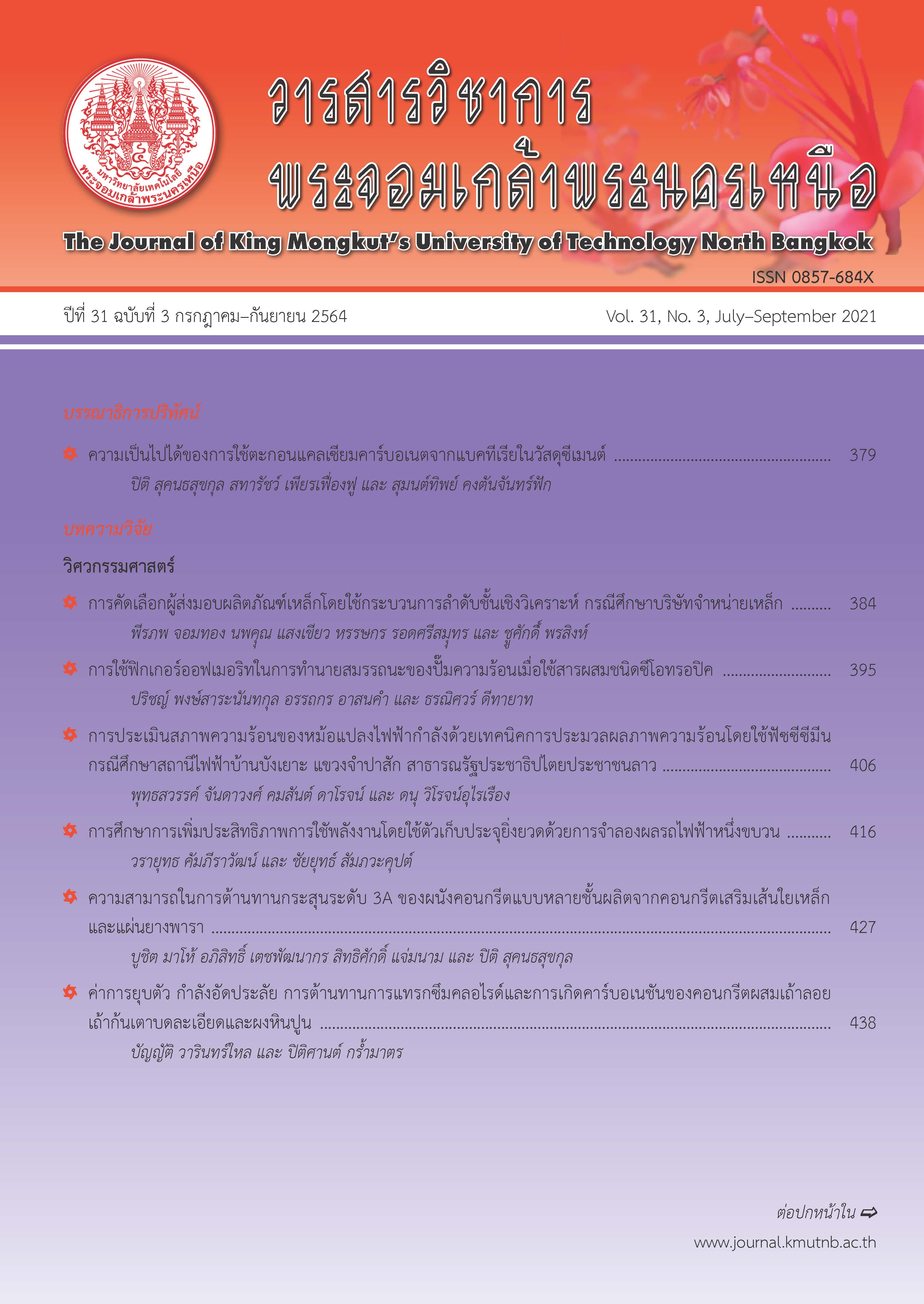การใช้ฟิกเกอร์ออฟเมอริทในการทำนายสมรรถนะของปั๊มความร้อนเมื่อใช้สารผสมชนิดซีโอทรอปิค
Main Article Content
บทคัดย่อ
ในปัจจุบันมีการใช้ปั๊มความร้อนอย่างแพร่หลายเนื่องจากเป็นเทคโนโลยีที่ใช้พลังงานต่ำและเป็นมิตรต่อสิ่งแวดล้อม ปัจจัยสำคัญที่มีผลต่อสมรรถนะของปั๊มความร้อนคือสารทำงาน ส่วนมากเป็นสารทำงานชนิดสารเดี่ยว ซึ่งพบว่าก่อให้เกิดสภาพการย้อนกลับไม่ได้สูง จึงได้มีการใช้สารทำงานชนิดสารผสมเพื่อช่วยลดสภาพการย้อนกลับไม่ได้เนื่องจากสารผสมจะมีการเปลี่ยนอุณหภูมิระหว่างที่เปลี่ยนสถานะ (Gliding temperature) ทำให้งานที่ใช้ในวัฏจักรลดลง ส่งผลให้สมรรถนะของระบบสูงขึ้น แม้ว่าปัจจุบันจะมีซอฟแวร์ต่าง ๆ ช่วยในการหาสมรรถนะของระบบ แต่สำหรับการใช้สารผสมในปั๊มความร้อน การใช้ซอฟแวร์ยังคงซับซ้อนและใช้เวลานาน งานวิจัยนี้ได้พัฒนาการใช้วิธี Figure of Merit (FOM) ซึ่งเป็นการรวมคุณสมบัติต่าง ๆ ให้อยู่ในเทอมไร้หน่วย เพื่อใช้สำหรับทำนายสมรรถนะของระบบได้อย่างรวดเร็ว โดยที่ไม่ต้องใช้การคำนวณด้วยวิธีทางเอนทัลปี โดยนำสารเดี่ยว 8 ชนิด ซึ่งพิจารณาจากคุณสมบัติทางเทอร์โมไดนามิกส์ ความเป็นมิตรต่อสิ่งแวดล้อม และความปลอดภัยในการใช้งาน มาผสมเป็นสารผสมแบบซีโอทรอปิค 12 ชนิด ในสัดส่วนที่ทำให้เกิดสมรรถนะการทำความร้อน (COPh) และสมรรถนะการทำความเย็น (COPl) สูงสุด ผลการวิจัยพบว่าการใช้สารผสมทำให้ระบบมีสมรรถนะสูงกว่าการใช้สารเดี่ยว และสัดส่วนของสารผสมที่ทำให้เกิดสมรรถนะสูงสุด อยู่บริเวณเดียวกับสัดส่วนที่ทำให้เกิดอุณหภูมิ gliding สูงสุด นอกจากนี้ เมื่อหาสมรรถนะของปั๊มความร้อนด้วยวิธี FOM พบว่าได้ผลลัพธ์สอดคล้องกับวิธีทางเอนทัลปีและการทดสอบกับระบบจริง โดยมีความแตกต่างเฉลี่ยไม่เกิน 3%
Article Details
บทความที่ลงตีพิมพ์เป็นข้อคิดเห็นของผู้เขียนเท่านั้น
ผู้เขียนจะต้องเป็นผู้รับผิดชอบต่อผลทางกฎหมายใดๆ ที่อาจเกิดขึ้นจากบทความนั้น
เอกสารอ้างอิง
[2] C. Arpagaus, F. Bless, M. Uhlmann, E. Büchel, and S. Frei, “High temperature heat pump using hfo and hcfo refrigerants - system design, simulation, and first experimental results,” in Proceedings of the 17 th International Refrigeration and Air Conditioning Conference, 2018, pp. 1875–1887.
[3] X. Shuxue, M. Guoyuan, L. Qi, and L. Zhongliang, “Experiment study of an enhanced vapor injection refrigeration/heat pump system using r32,” International Journal of Thermal Sciences, vol. 68, pp. 103–109, 2013.
[4] M.Ã. Mohanraj, C. Muraleedharan, and S. Jayaraj, “A review on recent developments in new refrigerant mixtures for vapour compressionbased refrigeration, air-conditioning and heat pump units,” International Journal of Energy Research, vol. 35, no. 8, pp. 647–669, 2011.
[5] M. Yilmaz, “Performance analysis of a vapor compression heat pump using zeotropic refrigerant mixtures,” Energy Conversion and Management, vol. 44, no. 2, pp. 267–282, 2003.
[6] S. Zhang, H. Wang, and T. Guo, “Experimental investigation of moderately high temperature water source heat pump with non-azeotropic refrigerant mixtures,” Applied Energy, vol. 87, no. 5, pp. 1554–1561, 2010.
[7] AHN. Khalifa, JA. Hamad, and HS. Abdulhussein, “Experimental study on auto cascade refrigeration cycle using mixed refrigerant,” Journal of Multidisciplinary Engineering Science and Technology, vol. 3, no. 10, pp. 5637–5641, 2016.
[8] V. Venzik, D. Roskosch, and B. Atakan, “Propene/ isobutane mixtures in heat pumps: An experimental investigation,” International Journal of Refrigeration, vol. 76, pp. 84–96, 2017.
[9] CR. Kuo, SW. Hsu, KH. Chang, and CC. Wang, “Analysis of a 50kw organic rankine cycle system,” Fuel and Energy Abstracts, vol, 36, no. 10, pp. 5877–5885, 2011.
[10] T. Deethayat, A. Asanakham, and T. Kiatsiriroat, “Performance analysis of low temperature organic rankine cycle with zeotropic refrigerant by figure of merit (FOM),” Energy, vol. 96, pp. 96–102, 2016.
[11] J.M. Calm and G.C. Hourahan, “Physical, safety, and environmental data for refrigerants,” HPAC Heating, Piping, Air Conditioning, vol. 71, pp. 27–29, 1999.
[12] E. W. Lemmon, M. L. Huber, and M. O. McLinden. (2013, May). NIST standard reference database 23: Reference fluid thermodynamic and transport Properties-REFPROP, version 9.1. [Online]. Available:https://www.nist.gov/publications/nist-standard-reference-database-23-reference-fluid-thermodynamic-andtransport
[13] Z. Sagia and C. Rakopoulos, “Alternative refrigerants for the heat pump of a ground source heat pump system,” Applied Thermal Engineering, vol. 100, pp. 768–774, 2016.

